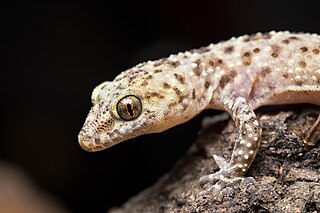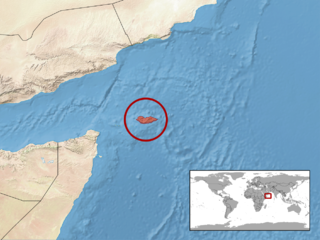
Gekkonidae is the largest family of geckos, containing over 950 described species in 64 genera. Members of the Gekkonidae comprise many of the most widespread gecko species, including house geckos (Hemidactylus), tokay geckos (Gekko), day geckos (Phelsuma), mourning geckos (Lepidodactylus) and dtellas (Gehyra). Gekkonid geckos occur globally and are particularly species-rich in tropical areas.

Hemidactylus is a genus of the common gecko family, Gekkonidae. It has 189 described species, newfound ones being described every few years. These geckos are found in all the tropical regions of the world, extending into the subtropical parts of Africa and Europe. They excel in colonizing oceanic islands by rafting on flotsam, and are for example found across most of Polynesia. In some archipelagoes, cryptic species complexes are found. Geckos like to live in and out of houses. They have been introduced to Australia.

The Indo-Pacific gecko also known as Garnot's house gecko, the fox gecko, or the Assam greyish brown gecko, is a species of gecko found in India, the Philippines, Southeast Asia, Australia, and throughout Polynesia. Adults are about 4 to 5 in in total length. They are seen as dark gray or brown with light markings in daylight and a pale, translucent colour at night. The belly is orange or yellow. The head has a long, narrow snout, hence the name fox gecko. The flattened tail has a row of spiny scales on the lateral edges. The species is parthenogenic – all individuals are female and lay eggs that hatch without requiring male fertilisation.

Hemidactylus prashadi, also known commonly as the Bombay leaf-toed gecko or Prashad's gecko, is a species of lizard in the family Gekkonidae. The species is endemic to the Western Ghats of India.

The Mediterranean house gecko is a species of house gecko common to the Mediterranean area which has spread to many parts of the world. It is commonly referred to as the Turkish gecko as represented in its Latin name and also as the moon lizard because it emerges in the evening.

The tropical house gecko, Afro-American house gecko or cosmopolitan house gecko is a species of house gecko native to sub-Saharan Africa. It is also currently found in North, Central and South America and the Caribbean, where it has been inadvertently introduced by humans.

The common house gecko is a gecko native to South and Southeast Asia. It is also known as the Asian house gecko, Pacific house gecko, wall gecko, house lizard, tayoto, chipkali or moon lizard.

The Mount Sinai gecko is a species of lizard in the family Gekkonidae. The species is endemic to Egypt.

The Antilles leaf-toed gecko, also known as the Maria Islands leaf-toed gecko or spiny gecko, is a gecko species found in northern South America and the Lesser Antilles. It can be found on small rocks and islets offshore of Saint Lucia, Trinidad, and Tobago, though it is absent from the main islands.

Hemidactylus depressus, also known as Sri Lanka leaf-nosed gecko or Kandyan gecko, is a species of gecko endemic to island of Sri Lanka.
The Bioko leaf-toed gecko is a species of forest geckos from Bioko Island. It occurs in the coastal areas of the island and it has also been found in a forest immediately adjacent to the beach.
Hemidactylus bouvieri, also known commonly as Bouvier's leaf-toed gecko and the Cape Verde leaf-toed gecko, is a species of lizard in the family Gekkonidae. The species is endemic to the Cape Verde Islands and is listed as critically endangered. There are two recognized subspecies.

The banded leaf-toed gecko is a species of gecko. It is endemic to West Africa west of the Dahomey Gap, from southern Guinea to Togo.

The Socotran rock gecko is a species of gecko. It is endemic to Socotra.
Hemidactylus modestus, also known as the moderate leaf-toed gecko or Tana River gecko, is a species of gecko. It is endemic to Kenya.
Hemidactylus puccionii, also known commonly as the Somali plain gecko and the Zanzibar leaf-toed gecko, is a species of lizard in the family Gekkonidae. The species is endemic to Somalia.
Hemidactylus squamulatus, also known as Tornier's leaf-toed gecko or Nyika gecko, is a species of gecko. It is found in eastern Africa.
Hemidactylus tanganicus, also known as the Tanzania leaf-toed gecko, Tanzanian diamond gecko or Dutumi gecko, is a species of gecko. It is endemic to Tanzania.
The Gujarat gecko is a species of gecko. It is endemic to India.
Hemidactylus ituriensis is a species of gecko. As currently known, it is endemic to northeastern Democratic Republic of Congo, although its true range probably extends eastwards to Uganda and Kenya. It belongs to the "Hemidactylus fasciatus species group".












